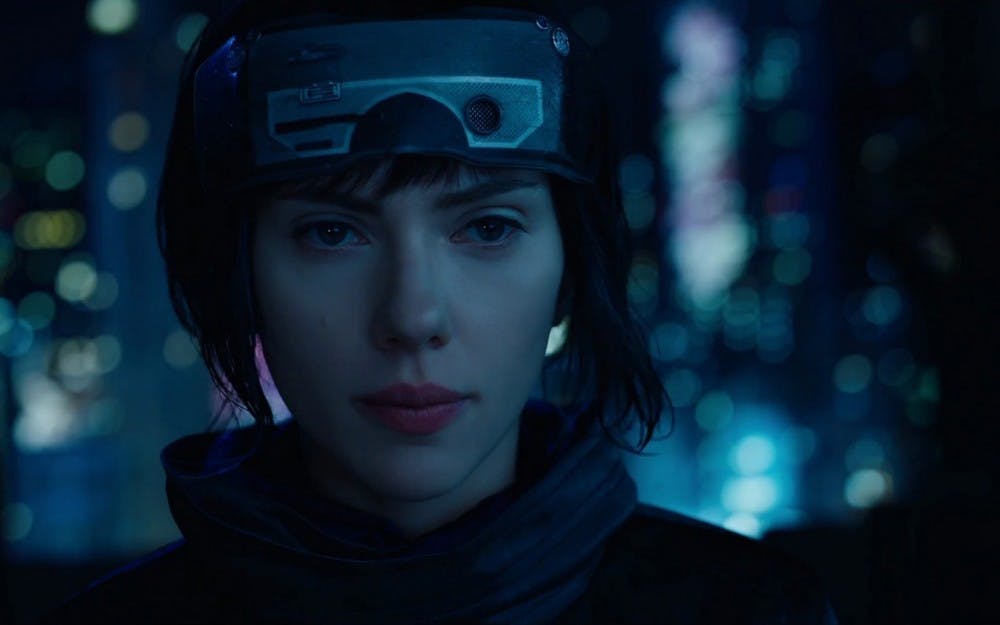Grade: D
Anyone with even the slightest interest in “Ghost in the Shell” has probably heard about the whitewashing controversy that dogged the movie since Scarlett Johansson took the role of the Major, a Japanese militarized cyborg.
But as soon as director Rupert Santers addressed the controversy by arguing that this adaptation would take place in a “multicultural, multiethnic and diverse landscape,” the question became not whether the movie would treat its Asian source material with respect but just how badly it would fail.
What’s surprising about “Ghost in the Shell” is how completely casual racism penetrates the movie from the choice of actors and scenery to throwaway plot points. Johansson wasn’t a great choice for the lead, but she looks a lot less bad compared to the rest of Sanders’ casting decisions.
In the movie, Major was built by robotics corporation Hanka and fights crime as part of a private police force. After an accident that left only her brain undamaged, Major is the inhabitant of the first entirely robotic body in the world. As she struggles to connect to her past, Major finds cracks in the story Hanka and her handlers have provided her about her past.Forcing a troubled protagonist to discover the secrets of their own past is a trite idea for a movie. This film ignores its rich source material instead making another vaguely anti-corporation, technology-heavy action movie.
The 2017 “Ghost in the Shell”adaptation is full of visuals that evoke the 1995 anime movie of the same name. Cinematographer Jess Hall recreated angles and sequences that will be instantly familiar to fans.
Sometimes this works. Briefcase-guns, hand and finger augmentations to make typing easier and cybernetic camouflage are all neat carry-overs into the new movie. Sometimes the anime stylization crosses over into campiness, though, like one discordant, re-created scene, where shimmering chime music is paired with shots of Major basically kicking the crap out of a truck driver in a few inches of murky water.
But fans of the anime will also come out of “Ghost in the Shell” disappointed. Visuals are the only thing lifted cleanly out of the story. Sanders builds an entirely new backstory for Major. The movie is entirely focused on how Major came to be and completely fails to consider what she can become. It’s another superhero origin story, but for a franchise that should absolutely not be continued.
Incredibly, Sanders has created an adaptation that borrows just enough from its source material to confuse any uninitiated viewer who thinks too hard about it but is even more confounding to fans of the original. A familiar storyline from the movie and an antagonist from the TV series are sloppily mashed together into a singularly disappointing villain-turned-antihero. Without the time or inclination to do more world-building, “Ghost in the Shell” doesn’t tap into any of the societal issues that made the original so popular. It also tries to take a post-racial stance on the whitewashing controversy, which is impossible to successfully portray. We do not live in a post-racial society, and pretending that this movie can accurately depict one is foolishness.
Anyone still planning to see the film should stop reading here and skip ahead, because we’re entering spoiler territory.
Hanka Corporation, attempting to create a humanoid weapon, overwrites Major’s past and gives her a new name, Mina Killian, and a backstory that involves immigration to Japan and an act of terrorism that killed both of her parents. In reality, she was born to a Japanese family, ran away from home to protest society’s new reliance on robotic enhancements and was arrested then used in Hanka’s experiments.
Sanders and company wrote Major’s whitewashing into the plot of the movie, possibly to deflect further accusations of erasure onto the all-powerful Caucasian villain, instead of the all-powerful Caucasian director.
What’s troubling is how Sanders seems to create a post-racial world that still places white people in a privileged position. It’s a way of avoiding accusations of racism without making any attempt to diversify the cast in anything but name — literally. Mina Killian is clearly a Western European name, yet she’s been given a refugee narrative in order to, one scientist reveals, make her more invested in fighting terrorism.
The corporation gives a clearly white character an experience shared mainly by non-white countries, as a way of overwriting her actual Asian heritage. There are actually a couple of ways in which this film could have used this plot point to make a statement. Sanders should have admitted in the movie that even in a cyberpunk future, national borders will exist. Exploring the effect of an influx of racially diverse refugees into this Japan could have tapped into current concerns about open borders, even if his refugees were white. He also could have focused on the rise of cyber-terrorism and a backlash against technological enhancements, which could have transcended racial divides in the movie in a way that no amount of defensive interviews could.
If Sanders hoped to subvert his own whitewashing in this movie, he probably shouldn’t have given every non-Asian character a Japanese name. Major answering to “Motoko” after her backstory came to light was a little cringey but bearable. Naming a teenager “Hideo” but casting an actor named Andrew Morris to play him? That’s just sad.
All but two named characters in this movie, in fact, are non-Asian. The setting, however, is choked with Japanese tropes — geishas, Yukuza, background characters in kimonos and parasols. However, almost all of the people we’re asked to care about are white. It seems Sanders likes the look of Japan on film but not the people who live there.
“Ghost in the Shell” has an interesting premise with a lot of potential for growth. Unfortunately, this remake barely scratches the surface. Stick to the anime, and skip this cybertronic mess.




